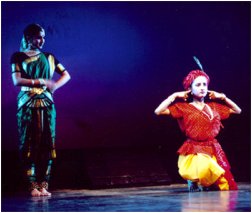 |
 |
Aadhunika and Aarambh
- two new productions from The Kirans
April 6, 2004 The Kirans - Kiran Subramanyam and Sandhya Kiran of Bangalore put up two new productions at Bangalore recently. AADHUNIKA - New Expressions in Bharathanatyam and AARAMBH - Contemporary Beginnings in a Timeless Tradition were both designed to explore the traditions of Bharathanatyam in unconventional ways, yet keeping intact the basic requirements of the form. |
 |
| Bharathanatyam
has come a long way since it first derived its name. This technique, though
comprehensive in itself, has been nourished and nurtured, generation after
generation, and has attained a form that we see it as today. In a sense
Bharathanatyam is one of the most traditional and classical styles of India.
Yet it is fluid enough to constantly evolve and transform, making it one
of the most contemporary art forms existing in the world today.
The present
generation has seen a dramatic change in the methods in which classical
dance can be presented. Contemporary styles of interpretation and visualisation,
use of technical support like lighting, stage decor and advanced sound
equipment have all enhanced the quality and presentation of classical dance.
AADHUNIKA was presented as a duet feature by Kiran and Sandhya. A set of six numbers made up the entire feature. Nrityodbhavam - the origin of dance was the initial number where the traditional Alarippu had been restructured to intersperse verses from the Natya Shastra. The choreography was a result of interesting interpretations of the Alarippu bringing the number to a stunning climax. Following this was a presentation of the popular Devaranama - Krishna Nee Begane Baro - where the dancers used the same lines -Kiran, to express Vatsalya and Sandhya to express Sringara. The central number was Shivarpanam - A piece on Lord Shiva. The piece was identified for its imaginative choreography and effective visualization, and was a classic attempt at dramatic and narrative interpretation. Following this was a novel way of interpreting the evergreen Devaranama Jagadodharana of Purandaradasa. Yashoda is in constant conflict about her son - Is he a mere mortal or is he the great Lord himself? Should she punish him for his pranks or should she revere him for his greatness? In this piece the traditional method of interpreting the Padartha is done away with. Instead it is depicted as a conversation between Yashoda and Krishna, one night. Kiran then performed his solo number-a heart rending Meera bhajan - Sharanagati. The presentation itself of this number was very different because of the use of a prop - a gigantic painting of a peacock feather and flute-that signified Krishna. The appearance and disappearance of the prop signified Krishna's benevolence and compassion that graces our lives. The recital concluded with a stunning climax - Natavara Sri Krishna - An adaptation of the traditional Thillana. The dancers wove a fantasy involving a lovelorn Nayika fantasising about her lord Krishna, giving the entire sequence a dream like quality. AARAMBH was presented by The Rasika Dance Ensemble - the performing unit of The Kirans' institution Rasika. The recital opened with a dramatic number of the same name which puts all aspects of Bharathanatyam in a nutshell. The dancers described in vivid patterns the techniques that make Bharathanatyam one of the most comprehensive styles of today. The different varieties of body movements were presented in visually delightful manners culminating in the emotional aspect of dance-the Navarasas. All aspects of Bharathanatyam - Angika, Vacika, Aharya and Satvika, were exploited in this number. Often dancers have wondered if it is possible to present a traditional Pada Varnam with group choreography. Also the introduction of theermanams in between, most certainly causes Rasa Bhangam - a break in the emotional build up of the Varnam. The Varnam presented here - Poorvikalyani - Swamiyai vara sholladi - was a welcome change in these two aspects. For one, the introduction of all the Ashtanayikas, in keeping with the lyrics of the piece changed the interpretation of the Varnam dramatically. Thus a group was effectively introduced in the Varnam format. Secondly, the Theermanams executed expressed the mood of the lines thus enhancing the emotion of the piece. Further the popular Surdas Bhajan - Maiyya Mori - was presented in the Natya format. It was a delightful presentation of the piece. AARAMBH ended with two pieces - one, an energetic, vibrant number on Shiva and the last, a visual interpretation of the Thani Avarthanam. AADHUNIKA and
AARAMBH were conceived, choreographed and directed by Kiran Subramanyam.
Both were highly acclaimed by the discerning audiences of Bangalore. Both
these features were appreciated for the crisp choreography and highly imaginative
interpretation. There was not one boring moment in the entire presentation.
It was certainly for the first time that traditional pieces were so innovatively
dealt with in the recent past. Several senior dancers, Gurus and critics
were present in the audience. The Kirans aimed these productions at the
younger generation and were extremely successful in harnessing the participation
of a majority of youngsters at the performances. The Kirans wish to revolutionise
the way Bharathanatyam is looked at and this attempt has certainly been
a successful one!
|